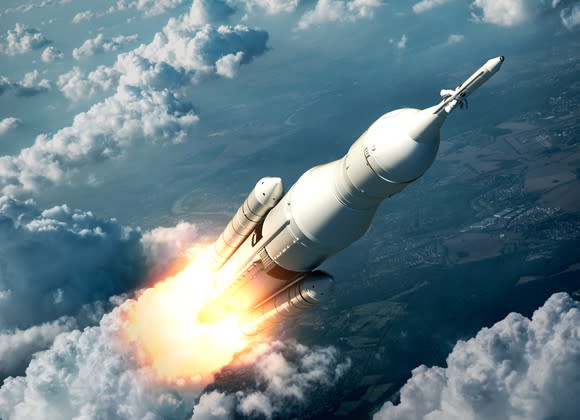Sales Surge, Profits Plunge at Aerojet Rocketdyne
Aerojet Rocketdyne (NYSE: AJRD) stock lost 12% of its value in the two days after the company reported earnings for the first quarter of 2018 -- a miss, and its third such miss in a row, according to data from Yahoo! Finance . Since that report and subsequent drop, however, Aerojet Rocketdyne has come roaring back, recovering all of its losses, and even adding a bit more.
At last week's closing price of $28.72, Aerojet Rocketdyne stock now costs about one dollar a share more than it did pre-earnings. So what went wrong two weeks ago? And what's gone right since then?

After a rough start, Aerojet stock is taking off like a rocket in May. But can it maintain momentum? Image source: Getty Images.
The bad news
Let's start with Aerojet Rocketdyne's Q1 earnings release, which came out on May 1. Profits for the fiscal first quarter more than doubled to $0.18 per share, while sales jumped 21% to $492 million.
Now, that sounds like good news, but analysts were predicting that Aerojet would earn $0.19 per share (an "earnings miss"). And although it's true that Aerojet's sales number significantly exceeded Wall Street's expectation for $417.5 million, the company changed its method of revenue recognition earlier in the year, which means the company's "sales beat" may not have been as significant as it looked on the surface.
Management noted that about seven points worth of its sales growth resulted either from acquisitions (of Coleman Aerospace) or the changed method of revenue recognition. Backing out these factors, you could argue that adjusted sales for the quarter grew organically only to about $462 million -- although this would still have been enough to beat sales estimates.
On the other hand, Aerojet's performance when it comes to cash production was simply abysmal. The company consumed $95.4 million in cash from operations compared to last year's cash from ops of negative $3.1 million. Granted, management attributed the weak cash flow principally to the timing of receipts from customers, with many customers paying early in late 2017. Still, once you subtract a further $4.1 million in capital spending, Aerojet Rocketdyne ended up with negative free cash flow of $99.5 million for the quarter.
Thus, bad news on earnings and free cash flow outweighed good news on sales (which itself wasn't as good as it seemed) -- and this explains the stock's initial sell-off.
The good news
But the news wasn't all bad. CEO Eileen Drake noted that U.S. Congressional FY2019 appropriations for both the nation's space and defense budgets showed "significant" increases over fiscal-year 2018 levels. Appropriations included $13.9 billion for missile defense and $2.2 billion for NASA's new Space Launch System, both programs in which Aerojet Rocketdyne has significant stakes. So although Aerojet Rocketdyne's backlog shrank during the quarter, there's at least some hope that new contracts are on the horizon.
Supporting this view, Aerojet issued a pair of press releases in the days following earnings. In one , the company announced the completion of "hot fire" testing of the engines it provides to the Missile Defense Agency (via Boeing) for the "Redesigned Kill Vehicle (RKV)" used in the U.S. Ground-Based Midcourse Defense program for ballistic missile defense. Aerojet noted that this test "marked a major milestone for the RKV" and sets the stage for the next phase of testing, a critical design review.
In a second press release, Aerojet confirmed that United Launch Alliance has picked Aerojet to provide RL10 rocket engines to power the upper stage of ULA's new Vulcan Centaur launch vehicle. Vulcan Centaur is the new rocket ULA is developing to replace its existing fleets of Atlas V and Delta IV launch vehicles. As such, Aerojet's winning a position as provider of the rocket's second-stage engine is key to the company's future role in space launch, and a good reason for Aerojet shareholders to cheer -- for now.
The upshot for investors
But here's the thing Aerojet Rocketdyne investors need to remember: Yes, ULA has tapped Aerojet to power its Vulcan second stage for now. Who will build the larger, arguably more important first-stage engines, however, remains up for debate (and currently, Aerojet's privately funded rival Blue Origin seems to be winning that contest).
What's more, ULA plans to switch out its Centaur second-stage (and Aerojet's) engines for a new "Advanced Cryogenic Evolved Stage" (ACES) second-stage rocket, which may or may not include Aerojet's RL10 in its design, in 2023. Thus, Aerojet's victory on Centaur may be short-lived.
Perhaps as short as just four years.
More From The Motley Fool
Rich Smith has no position in any of the stocks mentioned. The Motley Fool has no position in any of the stocks mentioned. The Motley Fool has a disclosure policy.

 Yahoo Finance
Yahoo Finance 